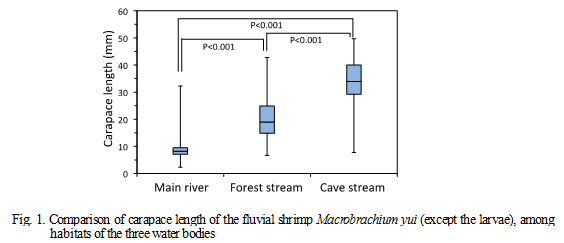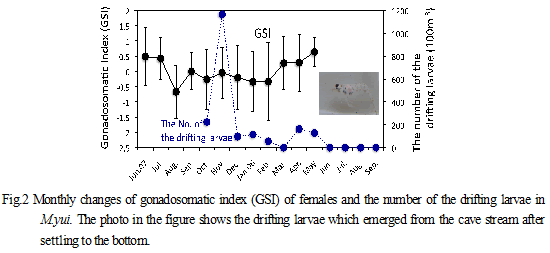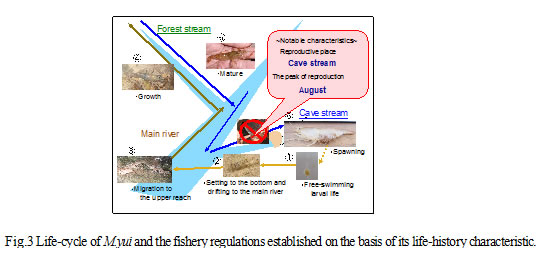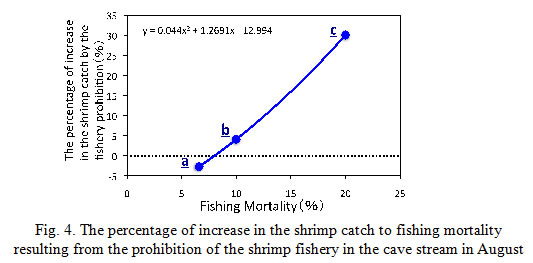Stock management of the fluvial shrimp Macrobrachium yui indigenous to northern Laos based on life-history characteristics
Description
Many Macrobrachium species are found in Lao People’s Democratic Republic (Lao PDR). In particular, Macrobrachium yui indigenous to the northern mountainous areas is well known as local delicacy and is traded at a high price, making shrimp fishing an important source of income for the rural people. However, shrimp catch has decreased year by year due to overfishing and deterioration of aquatic environments. This has become a big problem in the villages surrounding the shrimp’s habitat. In this study, we examined species identification, migration pattern, breeding habitat and season, and early life-history of the shrimp in order to develop effective technique of the shrimp stock management . The results are expected to contribute to the recovery and sustainable use of shrimp stock in the future.
Based on morphological characteristics, the species with the highest economic value was identified as Macrobrachium yui. Monthly sampling at fixed points showed that larger adults occur mostly in the cave stream; small-sized juveniles in the main river; and various-sized classes from the juveniles to the adults in the forest stream (Fig. 1). This suggests that the shrimp migrates among habitats of the three water bodies during its lifespan. Gonadsomatic index (GSI) of females greatly decreased from July through August and ovigerous females were found only from the inner part of the cave stream, indicating that females spawn in the inner part of the cave stream during the period (Fig. 2). The drifting larvae of the shrimp which had already settled to the bottom emerged from the cave stream from October through May. Based on rearing experiment in the laboratory, it was determined that the hatched larvae remained in the inner part of the cave stream for approximately one month (Fig. 3). In order to achieve recovery and sustain availability of the shrimp stock, prohibiting shrimp fishing at the cave stream during August was considered the centerpiece of fishery regulation. Fishery models were then created based on biological characteristics (i.e. female fecundity, seasonal change in the number of brooding females and growth patterns, etc.) of the shrimp to evaluate the effects of fishery regulation. The fishery model predicted that future catch of the shrimp increased by approximately 30% compared to current catch when the shrimp fishing at the cave stream during August was prohibited under the condition that actual fishing mortality is three times higher than the optimum fishing mortality (Fig. 4).
Backed by the prediction results of the fishery model, the fishery regulation was suggested to the local government. Based on Article 53 of the fishing regulations by the Ministry of Agriculture and Forestry in Lao PDR and at the initiative of the local government and villagers of Pak-Xuang District, Luang-Prabang Province, prohibition of shrimp fishery at the cave stream every August was adopted and enacted starting from year 2011.
Figure, table
-
a: optimal fishing mortality rate at present (6.6%)
b: fishing mortality rate of approximately 1.5 times a (10%)
c: fishing mortality rate of approximately 3 times a (20%).
- Affiliation
-
Japan International Research Center for Agricultural Sciences Fisheries Division
- Classification
-
Technical
- Research project
- Program name
- Term of research
-
FY 2011 (FY 2006-FY 2011)
- Responsible researcher
-
Ito Akira ( Fisheries Division )
Hanamura Yukio ( National Research Institute of Fisheries Science )
KAKEN Researcher No.: 50371951Iguchi Keiichiro ( National Research Institute of Fisheries Science )
Koji Omori ( Center for Marine Environmental Studies, Ehime University )
KAKEN Researcher No.: 10152258Kounthongbang Aloun ( Living Aquatic Resources Research Center, Lao PDR )
Lasasimma Oulaytham ( Living Aquatic Resources Research Center, Lao PDR )
Souliyamath Pany ( Na-Luang Fisheries Station, Luang-Prabang, Lao PDR )
- ほか
- Publication, etc.
-
Hanamura et al. (2011) Zootaxa, 3025: 1-35
Ito et al. (2011) Catch and Culture, 17, (2):24-27
- Japanese PDF
-
2011_11_A4_ja.pdf656.41 KB
- English PDF
-
2011_11_A4_en.pdf308.6 KB




